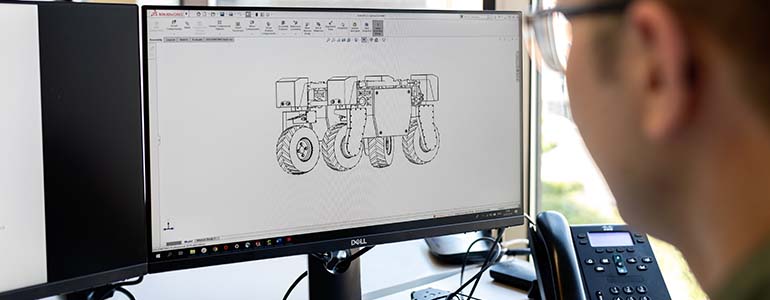
Improving the Design Process with Simulation
Table of contents
Invest Early to Improve Design
For many of the world’s top engineering companies, simulation software is invaluable.
For those that employ this tool in the early stages of development, large gains can be achieved. Integrating simulation software with your design engineers gives them another dimension to explore with their developments and ensures that they have the right tools at the right time to inform their decisions.
We often view product development cycles as linear processes where we deliver the final design to a simulation or manufacturing engineer to ‘build’ it and assess its suitability. By this time, a host of important questions have already been answered, and the product goes through a simple pass or fail gateway.
But, what if those previous decisions affect the cost, manufacturing time, or performance? What if they could run in parallel with development to improve one or many of these aspects?
Passing a simple gateway at this stage to say the product is ‘good enough’ would mean missing out on these gains entirely.
Although the cost commitments at the design stage are low compared to the project’s overall expenditure, the shadow cast by the design commitment is easily the biggest.
Investing a little more at this stage empowers your engineers, allowing them to create better designs for more suitable products that are likely to reap greater rewards further along this lifecycle.
How Reliable Are Hand Calculations and Physical Tests?
Existing Products
Many companies employ a methodology that looks at their existing, working product, and makes it bigger or smaller. While the historical data is useful and experience gained from this product gives some confidence in the ability of others, it doesn’t necessarily guide the design in a way that will make it better. It simply allows the development to make another version of something that is good enough, rather than something best suited to current requirements.
In turn, this provides a very stagnant development process and is unlikely to yield cost, timing, or performance gains that ensure the company remains competitive.
Spreadsheets and Hand Calculations
A traditional approach to assessing a design, engineers are comfortable with hand calculations and trust the feeling of reliability and accuracy they can achieve.
This is especially true when compared with unfamiliar simulation tools.
Hand calculations often require the engineer to make significant assumptions on geometry, materials, or load criteria. This limits their impact and places them more in line with a rough estimation than an accurate analysis.
However, there is still a feeling that the tried and tested method is more suitable, which leads to questions about the validity of a simulation result. The value of the simulation lies in its ability to highlight other relevant areas of the design, though, allowing visualization of the stress in a system of the full path of a load.
Testing Prototypes
As with hand calculations, many engineers believe that test results are more real, and often hold them in higher esteem than simulation results.
But even though tests give excellent data and the desired realism of the situation, they give only one result and reference point.
If the design passed the test, but was about to fail, it would not be shown. What if the part passed the test and could realistically take twice the load?
Is this something to shout about to give competitive advantage, or is the product over engineered and cost savings could be made? What if you needed to assess a product against the upper and lower boundaries of its tolerances in wall thickness or material properties, for example?
This single point of reference can’t answer that, and when testing can be so expensive to conduct, it’s not feasible to repeat this process many times over.
With integrated simulation, engineers can parametrize their data points and assess the product over a far greater range of variables, usually in far less time than a single physical test.
With simulation built into the design process, continuous iteration, and understanding of the bigger picture, mean most risks can be designed out of parts earlier in the lifecycle.
Is Simulation a Requirement?
With the obvious advantages, you’d be forgiven for thinking that everyone uses this integrated approach. But, often engineers or their managers will give one of the following reasons for their decision not to invest in simulation tools:
“The Products Don’t Break”
Their performance is satisfactory, and they don’t need to improve them. This is common among companies who are trailing in their markets. Making this kind of statement is a sign that they’re not forward-thinking enough to push boundaries. Or otherwise, that they don’t have enough reference data to truly assess the product.
“Right First Time Design”
While it’s entirely possible to develop a product that fits its specification on the first attempt, it’s impossible to know whether this attempt was the best it could be.
The only way to assess a product properly is by introducing a range of reference points via iterative development. These reviews must allow it to converge on the best fit result where improvements no longer occur, where developments show diminishing returns for further investment.
“Simulation is Time Consuming”
Most engineers think of the traditional approach to simulation. Of sending a final design to be analyzed once completed. This level of detail means that there are more components taking longer to mesh, debug, solve, and then interpret results.
When we integrate the process, the level of detail is far lower, but more common. This means that results can be achieved more quickly and make more impact on the project direction.
“Simulation Requires Specialist Knowledge”
This was once the case. And many engineers believe it still is. But, software like the 3DEXPERIENCE platform delivers simulation tool sets straight to the engineer to use alongside their traditional 3D modelling apps.
The level of integration between these tool sets has improved tremendously. And now, seamless interaction, edits, reruns, and other facilities are available and far easier to utilize and receive useful results.
Specialist roles in simulation are still common in situations requiring more advanced engineering, for research and development projects, or in this instance, the complexity of final designs and their need for experience to assess as a whole package.
Finding the Shortest Development Route
The cheapest way to develop a new product is for the process to be as linear as possible between concept and manufacture.
Each time designers make decisions on the project, there’s a chance that the path they take may lead them off on a tangent. Integrating simulation tool sets into the process means that these decisions can be validated sooner rather than later.
This means that although they may have taken a path that deviates from this perfect development direction, it can be quickly assessed and, if needed, resolved.
The length of the ‘line’ between concept and solution can be interpreted as either time or cost. And, by using an iterative verification process, it’s easy to see how the total length could reduce significantly, as shown in the graphic below.
Another benefit to a combined process is the amount of experience that the engineer gains as they go through this journey. When able to check their own decisions as they go along, they better understand why they are making them and how they affect the development.
It’s then easier to see why an engineer with more experience will introduce certain features into their designs. The feedback loop that’s generated means the engineer can ask a question of the system, receive a valid response, and then take that knowledge on board for future developments.
Management Buy-In
Integrating simulation into the design process is a task that process managers must understand and support.
It’s not enough to simply pay for the software or licenses. To achieve improved results, you have to make sure that you use the software to deliver the gains that are available.
How many companies buy a seat of simulation software and only make use of its capabilities when something’s gone wrong? Or on the odd occasion when something out of the ordinary has changed?
Supporting this directive means involving it in the workflow fully, holding it in appropriate standing, and allowing visibility of approval to empower the engineers to push the technology they believe will bring better results.
There’s also a requirement to understand the limitations of the integration and when involving specialist software is suitable. There are differences between using designer-level simulation and employing a full analysis as a form of digital prototype to replace conventional physical parts.
Both hardware and software requirements might change. But, the experience of a specialist, to understand the given information can be a crucial advantage. Knowing how to get the best out of the data that’s being generated can be vital to the project.
A specialist simulation engineer can also be a mentor if you’re able to draw them into the feedback loop, so that the engineering team can benefit from their assessments and interpretations.
In Our Experience…
Ultimately, most companies will still use a physical test model as their measure of success. Using simulation to mimic this is certainly possible, but not many will invest enough to make this realistic.
However, employing simulation-driven design from the outset of the project means that errors are more likely to be caught earlier on. And that means the expensive stage of physical prototyping and testing is more likely to be successful.
Revisit your approach on your products. It’s easy to think it’s good enough, without continuing to explore how it can be better.
Discover Modeling & Simulation (MODSIM) a data-driven, collaborative approach to product development that puts simulation in the driver’s seat.





